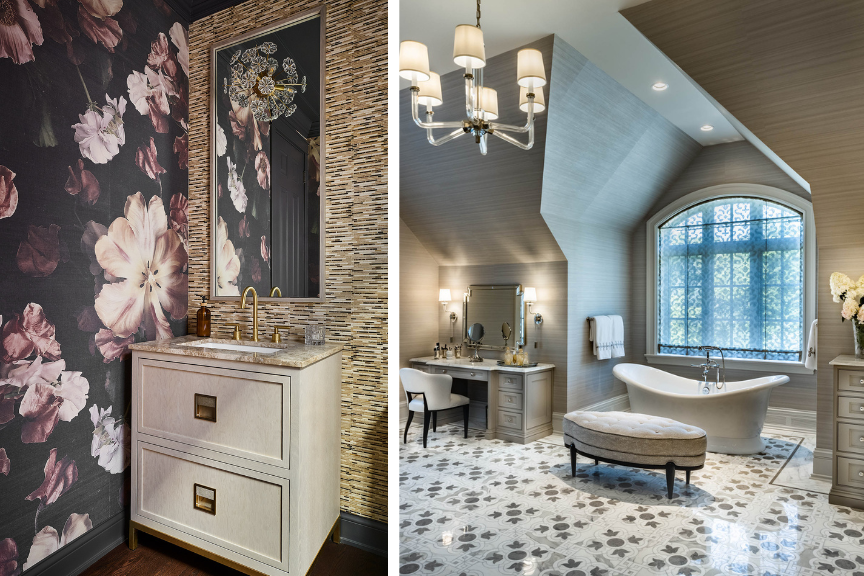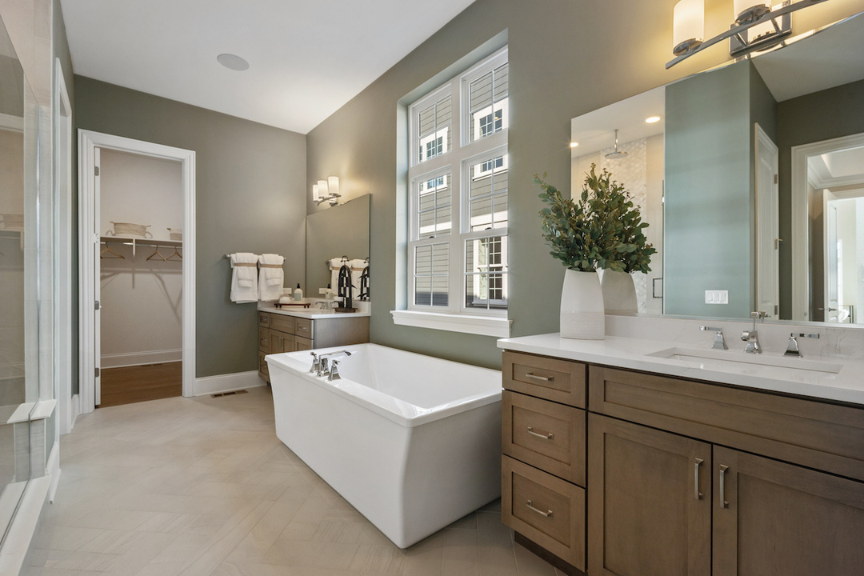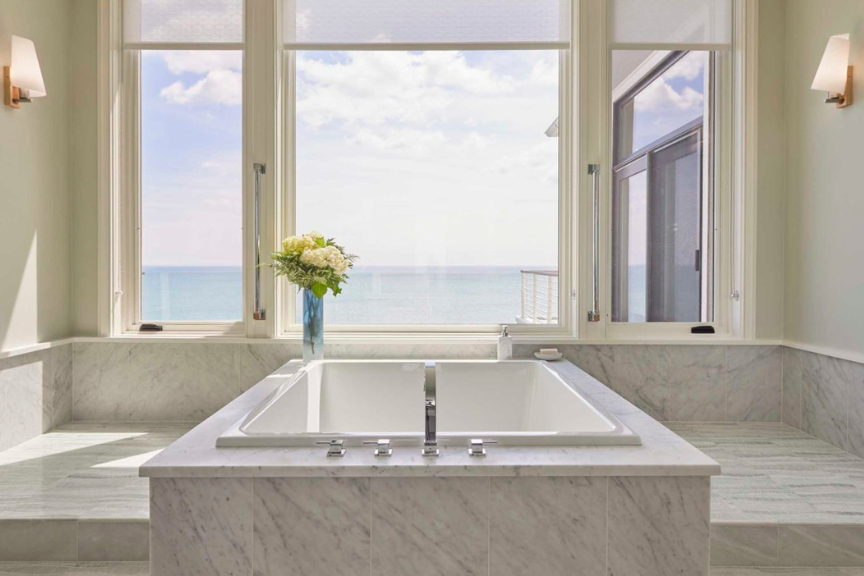
While bathrooms are becoming more compact, they’re not compromising on luxuries. Cutting-edge technology, comfort, and a serene spa ambiance remain integral.
Three key takeaways:
- Bathrooms are getting smaller, and design must accommodate the space constraints.
- Technology makes the space cleaner, more efficient and advanced.
- Though the costs of construction and material are climbing, a splurge or two should be budgeted to add joy.
Bathrooms are expected to get smaller in new construction, according to Carrie Tolman, associate principal with KTGY Simeone Deary Design Group in Chicago. As such, she expects the popular spa-inspired bathroom will gain more appeal, since its hallmarks make it feel larger and more luxurious.
When it comes to remodeling or building new, though, aesthetics aren’t the only driving force. COVID-19 sparked a desire for a greater sense of cleanliness, which has spurred interest in features like antimicrobial surfaces and self-cleaning toilets. Likewise, efficiency and environmentally friendly materials reign supreme for many.
Technological and material improvements offer benefits such as the ability to dim lights to conserve energy; toilets that can deodorize air, offer dual flushing, heat seats and automatically open and close their lids; showers with steam units to warm arthritic joints; and outlets in medicine cabinets and vanity drawers for quick convenience.

On the fun front, the rooms have become an entertaining mecca. According to the National Kitchen & Bath Association’s 2024 Bath Trend Report, they now feature everything from integrated audio to beverage stations with coffee makers and even small refrigerators for skincare products or cold drinks, says Pamela McNally, senior vice president of marketing and digital at the association.
Due to rising prices for products and labor, designer Charleene Doverspike of Charleene’s Houses near Baltimore says, remodeling costs for bathrooms have increased more than for any other room. Part of the reason, she adds, is that most of her clients seek a luxurious, relaxing vibe that calls for high-end materials, fixtures, faucets and fittings. Chicago-area broker Danielle Wylie of Baird & Warner agrees that buyers want an upscale, personalized ambiance rather than what’s seen everywhere. Remodeling magazine’s 2023 Cost vs. Value Report puts the average midrange bath overhaul at $24,606 with a 66.7% return on investment and an upscale redo at an average of $76,827 with 36.7% payback.
To keep within a budget and attract buyers, Marina Case, principal designer at The Red Shutters in upstate New York and Martha’s Vineyard, steers clients to classic choices for big-ticket items. Here are other tips to share, along with the caveat that no single choice is favored by all, say both designers and the NKBA.
Color Palette
The spa influence shows up in mostly pale palettes of gray and white to help create a healing, relaxing vibe that Wylie says many buyers favor. However, pale greens and other hues that can also contribute are showing up in many primary bathrooms, says Denise Benach, director of design at Lexington Homes in Chicago. In fact, the NKBA report says green is preferred to white.

And some gravitate toward what’s different, such as dark palettes for a moody Gothic effect, says Nancie Allen, senior designer at Joshua Zinder Architecture + Design in Princeton, N.J. Generally, the primary bathroom is a place where pops of color are used sparingly, she says.
A secondary or kids’ bathroom is the place to have fun with bolder colors and patterns, and a powder room may be a good place to use wallpaper, including today’s big florals, says designer Tom Segal of Kaufman Segal Design in Chicago.
Shower Style
After years of interest in bigger showers, fewer people want oversized spaces due to room size limitations and the realization that it’s harder to keep a big space warm, says architect Bob Zuber, associate principal with Morgante Wilson Architects outside Chicago. They also don’t want so many gadgets that mimic a car wash, Segal says. The NKBA report cited the use of touch pads, signaling a rise in shower experiences using technology. Comfort is a must, and a bench or ledge is often popular.
Niches are common, now in an elongated narrow shape for bathroom products, says Dominique Bonet, partner and lead designer with LD&D Design in Miami, and may be designed with the same tile or stone as the shower wall. Doverspike also likes niches that blend in: “The goal is to make it seamless with the entire space,” she says. Homeowners with larger budgets may add a steam unit, which could run from $5,000 to $7,000. Another luxury option is to place a tub and shower in an open “wet room,” which Bonet sets atop a platform as a focal point. Some other designs forgo any door, according to the NKBA.
Future Proofing
Safely aging in place, what Zuber terms “future proofing,” has led to more zero-threshold showers and tiles with grout to prevent slipping. Additional features include higher vanities for less bending, grab bars by a toilet and in a shower or tub, accessible light switches and higher toilet seats.
Tub Allure
Despite talk of tubs disappearing, most homeowners still want one in their house, primarily for resale or for children, says Wylie. If they have room and their budget permits, oval-shaped freestanding models remain popular because of their glamorous look, Bonet says. “A lot like it because it offers them a moment of relaxation,” she says.

Toilet Tower
If there’s space, homeowners still want a water closet or at least a partial wall for privacy. Though Toto and other brands manufacture upscale models with many features, including a bidet attachment, not all homeowners seek that amenity given the increased cost.
Vanity Stars
Wylie says many buyers prefer long countertops with ample space and two sinks when space allows. These days, wood is favored, particularly a light option like white rift oak or a bright walnut, Segal adds. The countertop is most likely to be a quartzite, natural stone or marble, though some avoid marble for fear of damage. Segal says renewed interest in medicine cabinets make them more popular, and it’s been modernized with brass, matte black or polished nickel edging rather than chrome, outlets in interiors, and sometimes an integrated light and defogging device.
Lighting Layers
A mix of LED layers, such as sconces by a medicine cabinet or on a mirror and recessed cans in toe kicks and often over a tub, offer good light says Benach. The ability to dim lights is essential. The room also looks best if there’s a window for natural light.
Tile Style
Doverspike hears more requests for zellige handcrafted-style tile, which originated in Morocco and was made from local clay, glazed and fired to highlight irregularities. It’s generally used on walls. Others favor classic subway tiles in herringbone or chevron patterns, says Allen. Benach likes porcelain tile both on walls and floors because it’s durable, impervious and affordable.

In many cases, floor tiles have gotten larger, but patterns like herringbone and hexagons are still popular, especially in the shower, the NKBA says. Segal sees a trend toward marble tiles that suggest movement, stones that are waterjet-cut into interesting patterns, and cement tiles with decorative patterns. For floors, there are other options. Karastan suggests BelleLuxe waterproof laminated wood with a proprietary WetProtect system that protects the subfloor, too, and LuxeCraft is a luxury vinyl tile that withstands water.
Where to Splurge—and Not
The comfort of heated floors has made them more popular, while heated towel racks are less requested. More wallpaper choices can now withstand the room’s humidity. For those who love nature, the bathroom can be ideal for displaying plants, Allen says. Faucets can become eye candy, and a good ventilation system provides cleaner air and a quieter backdrop.
What to forgo: Bonet cautions against spending too much money for matte black products, saying that the trend may decline over time. Others suggest avoiding electric fireplaces, cultured marble countertops, acrylic tubs and showers, partly tiled shower walls and low 14-to-17-inch-high tubs. The NKBA report nixes Hollywood-style lights.
